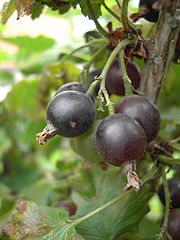
Jostaberry
Encyclopedia


Ribes
Ribes is a genus of about 150 species of flowering plants native throughout the temperate regions of the Northern Hemisphere. It is usually treated as the only genus in the family Grossulariaceae. Seven subgenera are recognized....
genus. The scientific name is variously Ribes nidigrolaria, or Ribes x nidigrolaria, or Ribes x culverwellii, or Ribes nigrum x uva-crispa. It is commonly described as a cross between the blackcurrant
Blackcurrant
Blackcurrant, Ribes nigrum, is a species of Ribes berry native to central and northern Europe and northern Asia, and is a perennial....
and the gooseberry
Gooseberry
The gooseberry or ; Ribes uva-crispa, syn. R. grossularia) is a species of Ribes, native to Europe, northwestern Africa and southwestern Asia...
, but it is the result of a more complex breeding program initiated by Erwin Baur
Erwin Baur
Erwin Baur was a German geneticist and botanist. Baur worked primarily on plant genetics. He was director of the Kaiser Wilhelm Institute for Breeding Research . Baur is considered to be the father of plant virology...
at the Kaiser Wilhelm Institute for Plant Breeding Research
Max Planck Institute for Plant Breeding Research
The Max Planck Institute for Plant Breeding Research is located in Cologne, Germany. The institute was founded as part of the Kaiser Wilhelm Society as the Kaiser Wilhelm Institute for Plant Breeding Research in 1928 in Müncheberg, midway between Berlin and the German-Polish border...
in the early 20th century. Its ancestry also includes a species of wild gooseberry, Ribes divaricatum
Ribes divaricatum
Ribes divaricatum is a species of currant with three accepted varieties, and known by several common names, found in the forests, woodlands, and coastal scrub of western North America from British Columbia to California.-Varieties:...
. The name Jostaberry was created via combining the German words for blackcurrant and gooseberry, namely Johannisbeere ("Jo") and Stachelbeere ("Sta"). Following German pronouncation of "J", it may be pronounced "yostaberry" in English. The bush was first made available to the public in 1977. A number of varieties have been developed since then by various developers.
The shiny nearly-black berry, which is smaller than a gooseberry and a bit larger than a blackcurrant, is edible both raw and cooked. It is described as having a taste intermediate between a gooseberry and a blackcurrant, with the gooseberry flavor more dominant in the unripe fruit, and the blackcurrant notes developing as the fruit ripens. The ripe fruit will hang on the bush in good condition through late summer, but is very popular with birds. The somewhat unripe fruit can be used in cooking recipes as a gooseberry. Like blackcurrants the fruit freezes well, and like many other members of the Ribes genus it is rich in Vitamin C
Vitamin C
Vitamin C or L-ascorbic acid or L-ascorbate is an essential nutrient for humans and certain other animal species. In living organisms ascorbate acts as an antioxidant by protecting the body against oxidative stress...
.
Commercial production of jostaberries, as berries, is negligible. But the plants are commonly offered for sale as fruit bushes in Home Garden outlets, especially in the UK. Compared to most other fruits, harvesting jostaberries is relatively labor intensive per kilogram. They're a little harder to pluck than blackcurrants are. However, an advantage they have against the gooseberry is that the plant is thornless.
The plant itself grows to a maximum height of about 2m, flowering in mid-spring, with fruit setting and ripening on a similar timetable to the blackcurrant. The plant displays hybrid vigor, growing and fruiting well and being resistant to a number of common diseases afflicting other Ribes. In particular the plant is resistant to American gooseberry mildew, blackcurrant leaf spot, white pine blister rust, and big bud gall mite. Flowers are hermaphrodite and the plant is self-fertile following insect pollination. This hybrid plant is propagated by cuttings, not by seeds.

